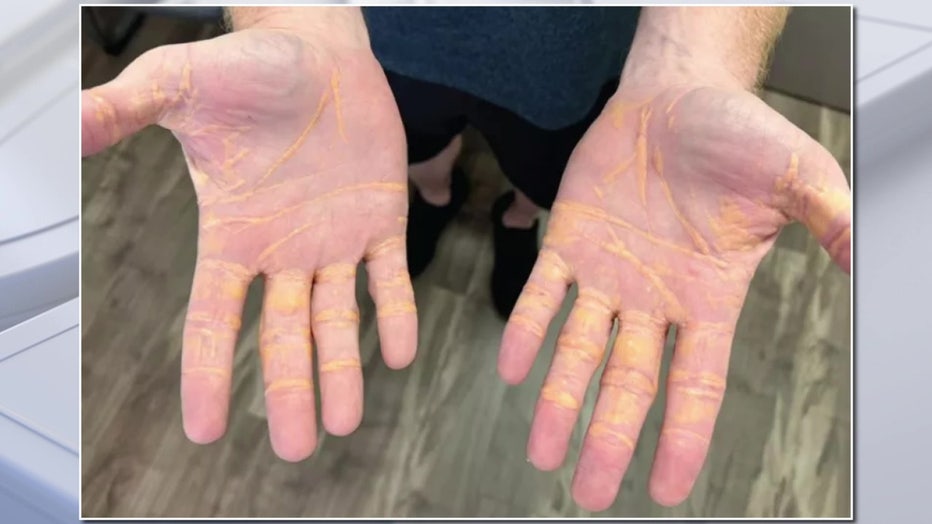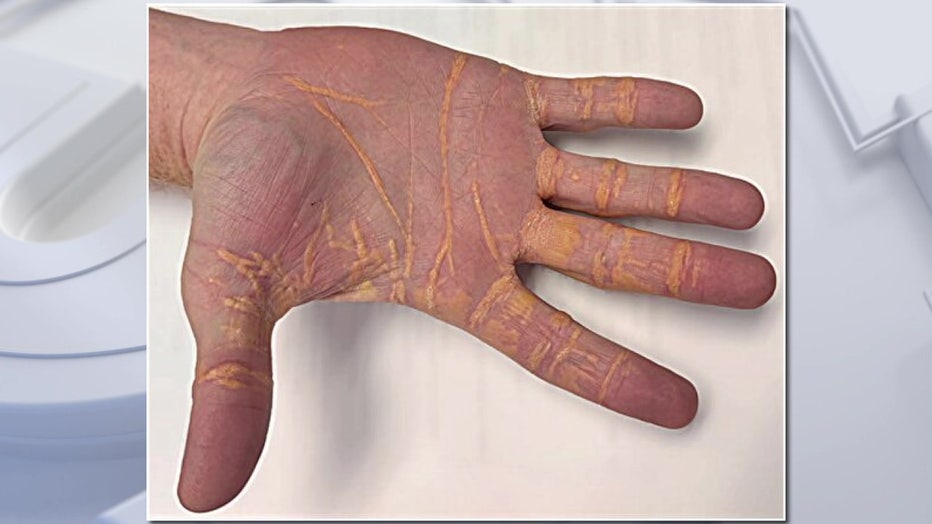Man eating 6-9 pounds of butter and cheese a day develops ‘cholesterol hands’ while on carnivore diet: JAMA
Carnivore dieter develops yellow cholesterol lesions
Doctors say a man developed yellow lesions on his body while following an extreme carnivore diet consisting of only butter, cheese and hamburgers for eight months. FOX 13’s Haley Hinds talks one-on-one with the interventional cardiologist who studied his case.
TAMPA, Fla. - A man who told doctors he ate nothing, but 6–9 pounds of butter, cheese and hamburgers every day for eight months ended up at Tampa General Hospital with yellowish lumps of cholesterol developing on parts of his body.
The backstory:
According to JAMA Cardiology, a man, who is only identified as being in his 40s, told doctors that he got diet advice from the internet and began following an extreme carnivore diet.
For eight months, he only ate 6–9 pounds of butter, cheese and hamburgers a day. He stopped eating all carbohydrates, such as bread and sugar.
At first, he said he felt great. He lost weight, became more energetic and had more mental clarity.
But after about eight months, he started developing yellow lesions on his eyelids. Over the next month, the yellow lesions appeared on the palms of his hands, the soles of his feet and his elbows.

Courtesy: JAMA Cardiology
Doctors diagnosed him with xanthelasma, a rare condition that impacts about 1% of patients with high cholesterol.
What is xanthelasma?
Dig deeper:
Xanthelasma is yellow raised deposits of cholesterol that appear under the skin because the body cannot process it.
It’s usually seen in people with familial hyperlipidemia, a condition in which patients cannot process cholesterol.
Dr. Konstantinos Marmagkiolis, an interventional cardiologist with Tampa Heart, Tampa General Hospital and USF Health co-authored a study on the patient for JAMA Cardiology said the lesions are not painful, but there is a concern about cholesterol.

Courtesy: JAMA Cardiology
According to Dr. Marmagkiolis, the patient checked his cholesterol levels every year for five years and they were normal. But his cholesterol increased five times abruptly after following the extreme carnivore diet.
What is the carnivore diet?
Big picture view:
The carnivore diet is a type of keto diet and consists of cutting carbohydrates and eating nothing but meat and animal products. The idea is that by cutting carbohydrates, the body will use fat for energy and people will lose weight.
Dr. Marmagkiolis says that when carbohydrates and sugars are abruptly decreased, the body starts using fat as the main fuel for energy. The body then goes into a process called deep ketosis, which is when it produces ketones.
Without using carbohydrates, there is a very stable energy level in the body. Dr. Marmagkiolis says the ketones are very good steady energy or fuel, and there is dehydration.
Patients are not retaining water, and they are losing fat and people usually feel great after starting a carnivore diet.
CLICK HERE:>>> Follow FOX 13 on YouTube
The carnivore diet gives results very fast and people who follow it will feel great in the first weeks or months.
Dangers of carnivore diet
The other side:
However, the problems start when people start eating too much fat, like this patient, and when cholesterol increases, it can deposit not only under the skin, but in other parts of the body and cause heart attacks and strokes.
Dr. Marmagkiolis recommends starting slowly.
He advises following a low-carb diet in the beginning and then moving on to a more balanced diet.
If someone does decide to follow the carnivore diet for a long period of time, they should work with a doctor or cardiologist to monitor their cholesterol levels.
Treating xanthelasma
Dr. Marmagkiolis says there is no treatment of medication for xanthelasma.
He says that even if the cholesterol is treated, the xanthelasma remains.
Dr. Marmagkiolis added that there are some good therapies a dermatologist can perform for aesthetic reasons, but doctors need to use the lesions as a marker of high cholesterol, which may be the first step of the body saying it cannot process cholesterol anymore, and it may deposit it in the body. That could be the first sign of atherosclerosis, the deposit of cholesterol in the arteries which increases the risk of heart attacks and strokes.
The Source: This story was written using information from a FOX 13 interview with Dr. Konstantinos Marmagkiolis, an interventional cardiologist with Tampa Heart, Tampa General Hospital and USF Health and co-author of the study in JAMA Cardiology.
STAY CONNECTED WITH FOX 13 TAMPA:
- Download the FOX Local app for your smart TV
- Download FOX Local mobile app: Apple | Android
- Download the FOX 13 News app for breaking news alerts, latest headlines
- Download the SkyTower Radar app
- Sign up for FOX 13’s daily newsletter

